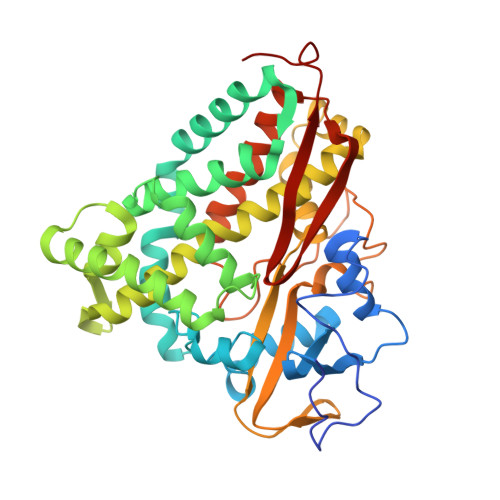Crystal structure of the cytochrome P-450CAM active site mutant Thr252Ala.
Raag, R., Martinis, S.A., Sligar, S.G., Poulos, T.L.(1991) Biochemistry 30: 11420-11429
- PubMed: 1742281
- DOI: https://doi.org/10.1021/bi00112a008
- Primary Citation of Related Structures:
2CP4, 3CP4, 4CP4 - PubMed Abstract:
The crystal structure of a cytochrome P-450CAM site-directed mutant in which the active site Thr252 has been replaced with an Ala (Thr252Ala) has been refined to an R factor of 0.18 at 2.2 A. According to sequence alignments (Nelson & Strobel, 1989), Thr252 is highly conserved among P-450 enzymes. The crystallographic structure of ferrous camphor- and carbon monoxide-bound P-450CAM (Raag & Poulos, 1989b) suggests that Thr252 is a key active site residue, forming part of the dioxygen-binding site. Mutation of the active site threonine to alanine produces an enzyme in which substrate hydroxylation is uncoupled from electron transfer. Specifically, hydrogen peroxide and "excess" water are produced instead of the product, 5-exo-hydroxycamphor. The X-ray structure has revealed that a local distortion in the distal helix between Gly248 and Thr252 becomes even more severe in the Thr252Ala mutant. Furthermore, a solvent molecule not present in the native enzyme is positioned in the dioxygen-binding region of the mutant enzyme active site. In this location, the solvent molecule could sterically interfere with and destabilize dioxygen binding. In addition, the active site solvent molecule is connected, via a network of hydrogen bonds, with an internal solvent channel which links distal helix residues to a buried Glu side chain. Thus, solvent protons appear to be much more accessible to dioxygen in the mutant than in the wild-type enzyme, a factor which may promote hydrogen peroxide and/or water production instead of substrate hydroxylation. On the basis of crystallographic and mutagenesis data, a proton delivery pathway involving residues Lys178/Arg186, Asp251, and Thr252 is proposed for wild-type P-450CAM. Coordinates of structures discussed in this paper have been submitted to the Brookhaven Protein Data Bank (Bernstein et al., 1977).
Organizational Affiliation:
Maryland Biotechnology Institute, University of Maryland, Shady Grove, Rockville, Maryland 20850.
















